|
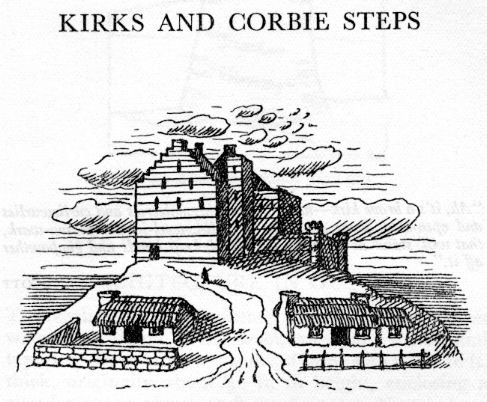
"Ah, it’s a brave kirk—nane
o'yere whigmaleeries and curliewurlies and open-steek hems about it—a’
solid, weel-jointed mason-wark, that will stand as lang as the warld, keep
hands and gunpowther aff it."
Scott
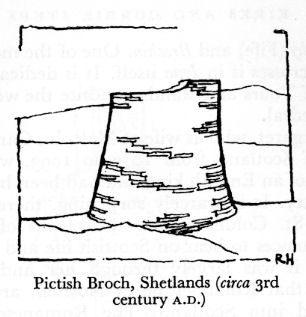
ARCHITECTURE IN OUTLINE
THE
earliest type of building you are likely to
meet with in Scotland is the broch, an open, round and tapering
tower superbly built of stone slab walls 16 ft. thick, originally about 40
ft. in height, enclosing a circular space about 40 ft. in diameter. No
windows pierce the walls, only a small door, while within the walls are
built galleries, cells and stairs, and a hearth and a well occupied the
centre space. Many brochs exist in the north and west of Scotland, dating
mostly from the first to the fifth centuries A.D., and they were used
either as a defence against sea-raiders or as the castles of a conquering
aristocracy. They are stark and solemn and have no parallel outside
Scotland.
The arrival of Columba at
lona from Ireland in the sixth century and his missionary successes among
the Picts on the Scottish mainland were the means of establishing cultural
relations between Ireland and Scotland. The architectural consequences
were, briefly, the hermit’s cell (to be seen at Inchcolm), the carved
Celtic cross, the square-ended plan for churches and the tall round refuge
towers to be seen at Abernethy
(Fife) and Brechin. One of the most
perfect of Celtic crosses is in lona itself. It is dedicated to St.
Martin of Tours and stands opposite the west door of the Cathedral.
St. Margaret, who as wife of Malcolm
Canmore was Queen of Scotland from
1070 to 1093, was granddaughter of an
English king and had been brought up in Hungary. It is scarcely
surprising, therefore, that she, like St. Columba, was the means of
bringing fresh influences to bear on Scottish life and architecture, and
it was largely through her and her son, David I, that Romanesque or Norman
architecture penetrated into Scotland. The Romanesque characteristics are
the round arch, generally massive proportions, flat wooden ceilings and
long narrow churches. The large Scottish churches of this time rank among
the great ones of Europe. Kirkwall Cathedral, begun in 1137,
is a noble building originally planned
in the orthodox Norman manner with a central tower, transepts with eastern
chapels, nave of seven bays, choir of three and a single eastern apse. The
interior is very high for its width. Dunfermline Abbey church nave
was the work of David I and is reminiscent of Kirkwall. (Note especially
the two spirally fluted and two incised columns at the east end.) The west
façade of Jedburgh Abbey is another important and striking example
of Norman work.
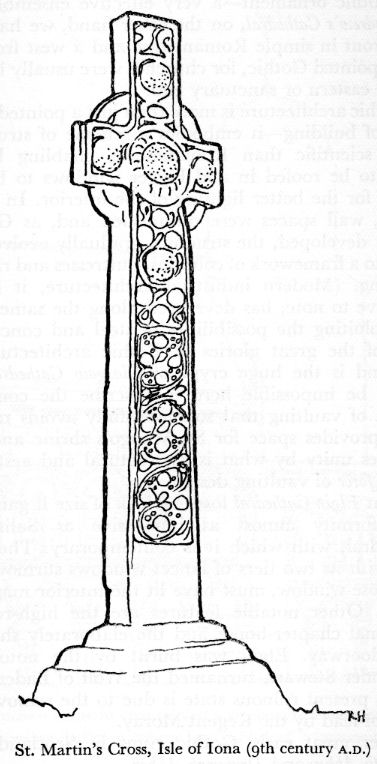
Several small Norman churches show
the influence of the square-ended Celtic plan—St. Oran’s at lona,
Stobo and Aberdour are all churches of this type that finds
no similar expression outside Scotland. The more usual Norman plan, with
an apse, can, of course, be seen at Dalmeny Church (which is
superb) or at Leuchars.
Scots were (and are) very fond of
sticking to certain features of building design long after they had been
dropped elsewhere, and the round arch is an example of this eclectic
conservatism; at the Nunnery chapel, lona
(1203), we find a round-arched arcade
accompanied by Gothic ornament—a very effective ensemble. At St. Andrew’s
Cathedral, on the other hand, we have an east front in simple Romanesque
and a west front in early pointed Gothic, for churches were usually begun
at the eastern or sanctuary end.
Gothic architecture is more than
just a pointed-arch style of building—it embodies a scheme of structure
more scientific than Romanesque, enabling larger areas to be roofed in and
bigger windows to be inserted for the better lighting of the interior. In
other words, wall spaces were diminished and, as Gothic design developed,
the structure gradually evolved itself into a framework of columns,
buttresses and ribbed vaulting. (Modern industrial architecture, it is
instructive to note, has developed along the same lines by exploiting the
possibilities of steel and concrete.) One of the great glories of Gothic
architecture in Scotland is the huge crypt of Glasgow Cathedral. It
would be impossible here to describe the complex system of vaulting that
so successfully avoids monotony, provides space for St. Mungo’s shrine and
yet achieves unity by what is a structural and aesthetic tour deforce
of vaulting design.
What Elgin Cathedral loses by
lack of size it gains by a uniformity almost as impressive as Salisbury
Cathedral, with which it is contemporary. The east end, with its two tiers
of lancet windows surmounted by a rose window, must have lit the interior
magnificently. Other notable features are the high-roofed octagonal
chapter-house and the elaborately shafted west doorway. Elgin was burnt by
the notorious Alexander Stewart, surnamed the Wolf of Badenoch, but its
present ruinous state is due to the removal of the roof-lead by the Regent
Moray.
Other great early Gothic ruins in
Scotland are Arbroath Abbey and Dryburgh Abbey.
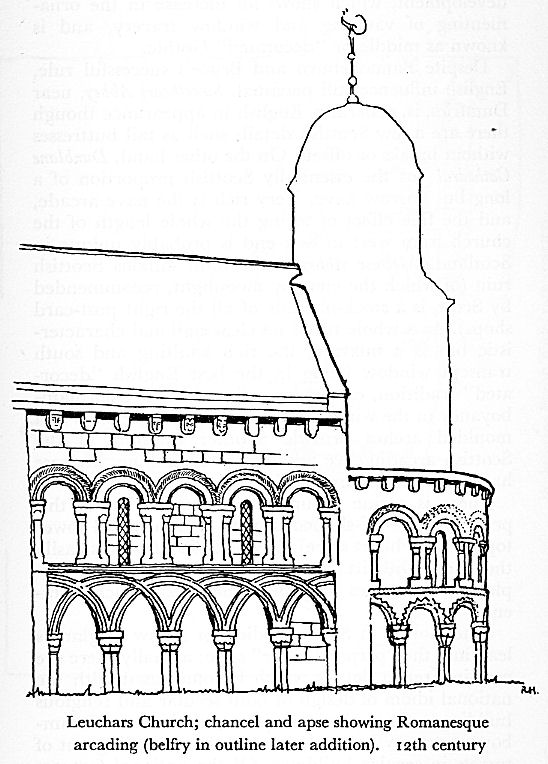
From the simplicity of early Gothic
with its lancet
windows ("Early English") we proceed
to the next development, which shows an increase in the ornamenting of
vaulting and window tracery, and is known as middle or "decorated" Gothic.
Despite Bannockburn and Bruce’s
successful rule, English influence still persisted. Sweetheart Abbey,
near Dumfries, is, generally, English in appearance though there are a
few Scottish details such as tall buttresses without breaks or offsets. On
the other hand, Dunblane Cathedral has the essentially Scottish
proportion of a long but narrow nave. Very rich is the nave arcade, and
the fine effect of seeing the whole length of the church from west to east
end is probably unique in Scotland. Melrose Abbey is the most
famous Scottish ruin (of which the view by moonlight, recommended by
Scott, is a stock-in-trade of all the right post-card shops). As a whole
it has no clear national characteristic but is a mixture, the rich
vaulting and south transept window being in the best English "decorated"
tradition, except for a flavour of French flamboyancy in the windows,
while the shafted pillars and moulded arches provide another example of
the Scottish arcading we admired at Dunblane. Melrose has the usual
Cistercian plan.
There is a fine group of parish
churches of this period in Fife (T-shaped in plan with a broad tower
topped by a blunt spire), of which St. Monans is easily the finest,
with its "decorated" window tracery displaying sometimes English,
sometimes French influence.
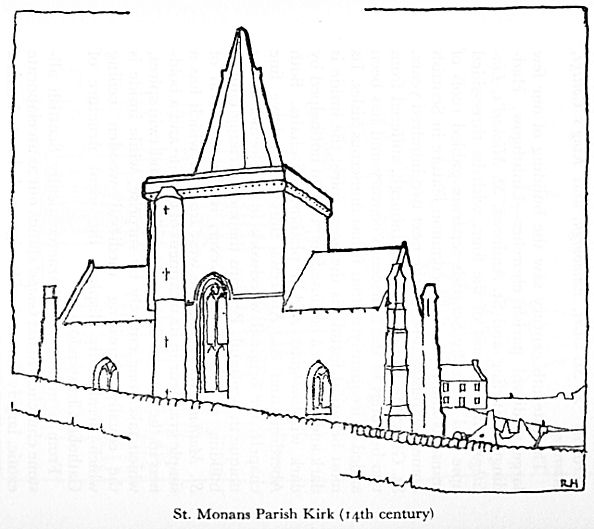
Late Gothic in Scotland did not
follow England’s lead into the "perpendicular" style; actually there are
certain French details which become fused with the national idiom of
design of both secular and religious buildings—the revival of apses and
the use of flamboyant tracery in windows, and the corbelling out of
turrets in secular buildings. Of the national features which developed
about now are the naïve curvilinear tracery, the stone slabbed roofing (to
be seen at Seton and Corstorphine), the elaborate
"Sacramental Houses" for the Elements, such as we see at Kintore
and Crichton churches, and lastly, the well-known open spires or
"crowns" at St. Giles, Edinburgh, and
King’s College, Aberdeen.
The fifteenth century saw the
building of our few large medieval parish churches—Linlithgow, Haddington,
Stirling and St. Andrews. St. Michael’s, Linlithgow, is the finest
of the four, with its three-sided apse and typically Scottish separate
gabled roofs of transepts and a porch—a common feature in Scottish
domestic architecture for the next two hundred years. St. Giles, the High
Kirk of Edinburgh, suffered from two burnings in the fourteenth century
and has been added to frequently so that it has numerous aisles. Its most
beautiful feature is the open spire: the inside is dark and conveys a
confused impression not helped by dark window-glass and a plethora of
chairs. Both Aberdeen and St. Andrews universities have fine chapels, the
original woodwork in the former being unique in Scotland. Perhaps the most
striking church building of this time, however, is the cathedral of St.
Machar, Aberdeen, the west front of which has a simple grandeur in its
treatment of granite and a boldness in the general design of windows and
twin spires, which takes one entirely by surprise, while inside is the
equally surprising medieval wooden ceiling which heraldically displays the
ideal structure of Catholic Christendom.
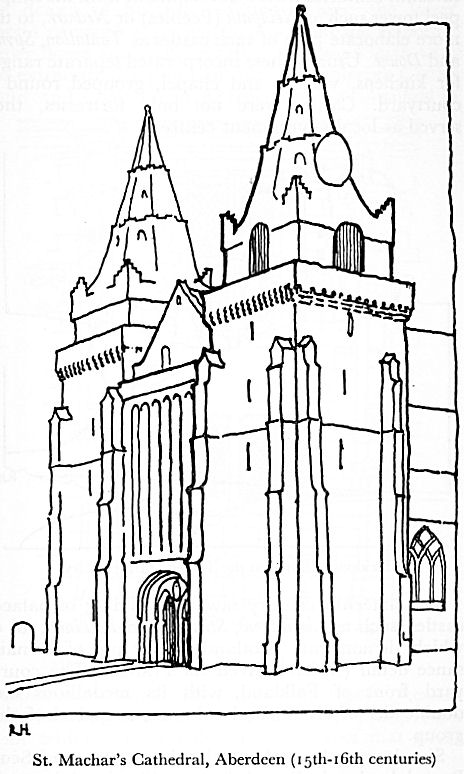
From a number of characteristically
Scottish all-stone churches, Roslin Chapel stands out as an
elaborate exotic, largely the work of foreigners. It has to be seen to be
believed.
The earliest medieval secular
buildings are thirteenth-century stone keeps (Dunstafnage or
Inverlochy), usually built with stone surrounds on promontories
overlooking river or loch, During the fourteenth and fifteenth centuries
we see development from the simple peel tower such as Neidpath
(Peebles) or Newark, to the more elaborate plan of such castles as
Tantallon, Spynie and Doune. Usually these incorporated
separate ranges for kitchens, visitors and chapel, grouped round a
courtyard. Castles were not only fortresses, they served as local
government centres.
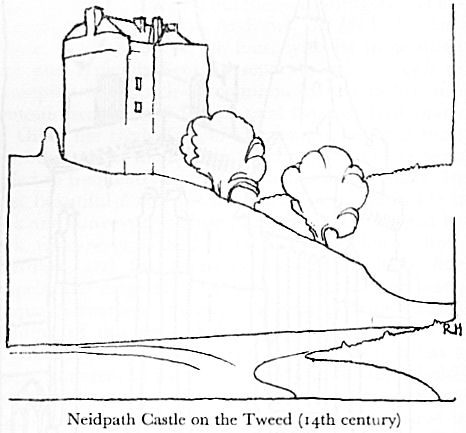
The sixteenth century saw the
building of palace-castles, such as Linlithgow, Stirling and
Falkland, all of which demonstrate Scotland’s early use of Renaissance
detail (which arrived via France). The courtyard front of Falkland,
with its medallions and double tier of ornamental columns, is typical of
this group.
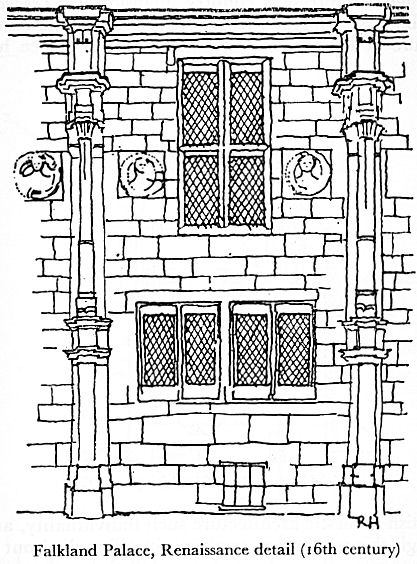
Simultaneously we have the
development of Scots Baronial, wherein French features like the
elaborately corbelled turret were welded with naïve ingenuity into the
design of Scottish fortified houses, the lower storeys of which were left
plain so that the elaborate upper floors and roof structure blossomed
forth with the extraordinary profusion that characterises Castles
Fraser and Craigievar in Aberdeenshire or Amisfield in
Dumfriesshire. Allied with this evident vigour of essentially
functional [Functional: a style of building wherein convenience and the
claims of structure dominate design, taking little heed of external
symmetry.] design was a sure sense of proportion—for seldom, if ever, do
we find a roof that seems "wrong" in shape.
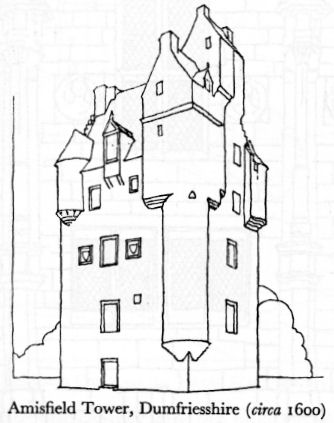
Meanwhile the ordinary house took
form and a few remaining examples reveal its naive and varied charm.
Perhaps the most interesting town houses are Provand’s Lordship,
Glasgow, The Palace, Culross, Acheson House, Edinburgh and
Argyll’s Lodging, Stirling, while by far the most impressive
country mansion is Traquair, rambling yet shapely, its lines
softened by the casual texture of harling. At no time before or since had
Scottish domestic architecture such individuality, and though this
wholesome tradition in effect died out in the seventeenth century, being
killed by the later Renaissance, it persisted much longer in cottage and
farm buildings: it was the native idiom.
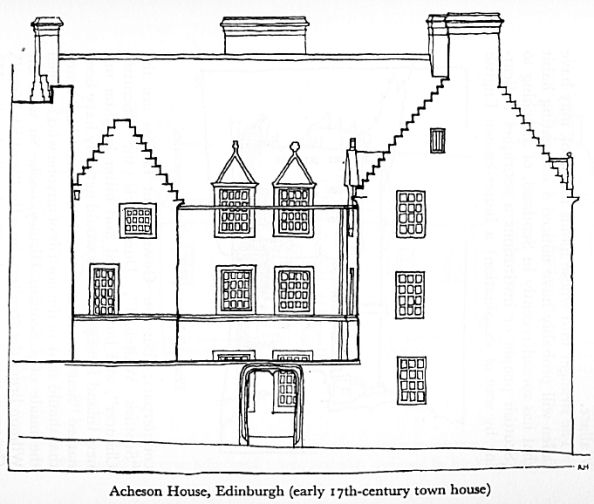
Two buildings occur about this time
which will strike the reader as out of the normal course. Heriot’s
Hospital and Wintoun House have generally a flavour foreign to
the strongly national tendencies of contemporary architecture. Their
details, notably the chimneys at Wintoun, are markedly English, and they
were built, it transpires, by the same master of works, Wallace.
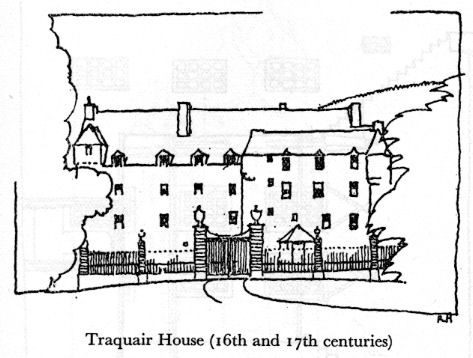
The stranger into whose hands this
book may have fallen will probably have noticed a nauseating habit that
has spread recently in Scotland, of attaching to (Scottish people or
institutions a sobriquet indicating by way of exaplanation) a better-known
English counterpart; thus our Government Offices are the "Scottish
Whitehall", Dunbar is the "Scottish Chaucer", and but for loud and bitter
laughter our new Inland Revenue offices would actually have been named
"Somerset House"—and "Somerset" is a name that should stink in the
nostrils of anyone who has seen the inside of a Scottish History book. So
with Sir William Bruce the architect, he is the "Scottish Wren".
Contemporary he certainly was, but little else. His most complete work is
Kinross House and garden, his most famous the main court of
Holyroodhouse. Both are refined and neither is the least English, but
rather

French in flavour. It is rare to
find a house and garden in such harmony of design as Kinross, with several
garden houses and the famous "Fish-gate" opening on to Loch Leven. Bruce
built it for himself and it is clearly an architect’s house. The 1691
front of Caroline Park, Edinburgh, is probably his most original work.
French in general appearance—it has been likened to a Burgundian
manor-house—but unmistakeably Scottish in its sly detail. Following on and
influenced by Bruce came William Adam, the father of sons whose fame has
eclipsed his own. But the old man had great talent, and as he was
responsible for introducing the Palladian style into Scotland, he may be
said to have bridged the gulf between Scottish and English architecture.
He designed Yester House, The Drum near Gilmerton, Mellerstain near the
Border, and Hopetoun House, where he incorporated work by Bruce. He also
designed the now demolished Town House at Dundee. His celebrated sons did
most of their work in England, but in Edinburgh will be found their
University Buildings, the Register House and the magnificent Charlotte
Square, the north side of which has recently been restored and is worth a
visit; it is well massed yet delicate in detail. The work of the sons is
more refined than the father’s—sometimes it comes dangerously near the "refaned".

The best monument of this age is the planning of
Edinburgh’s New Town; the view down George Street from St. Andrew Square
gives perhaps the most complete impression. Adam’s University Building in
Edinburgh was finished and altered by Playfair, who was a leading
architect of the Greek revival that flourished in the early nineteenth
century, and his University dome is of excellent proportions. The
vestibule of his Academy at Dollar is worth seeing, and more convenient
perhaps, the National Gallery in Princes Street and the fine façade of
Royal and Regent Terraces in Edinburgh. Hamilton was another important
architect of the time, and his Royal High School is a bold Athenian
group of buildings of grace and dignity on the rocky slopes of the Calton
Hill, Edinburgh. The Greek revival was strongly expressed by "Greek"
Thomson in the west of Scotland, and his St. Vincent Street Church,
Glasgow, is easily the most striking example of this movement. Note how
splendidly the advantage of the sloping site has been used.
And now we come to what is the very depth of Scotland’s
architectural winter, for the neo-classicism of the Adams and the Greek
revival almost knocked the life out of native architecture, which retired
to obscure farm buildings and cottages.
Thirst for the romantic impelled our fathers and
grandfathers to revive Scots Baronial as a style. Probably their most
thorough revivalist debauch is epitomised in Balmoral, but the
habit spread throughout the kingdom, ranging in expression from the
mansions of county families to the turreted villas of Edinburgh’s suburbs.
And of course there was Abbotsford. Of these all that can be said
is "Non ragioniam di lor, ma guarda e passa".
As imitations of the real thing they are all depressingly amateurish,
they abound in restless lines and hard textures, and their interiors are
veritable forests of varnished pitch-pine.
Gothic was, of course, deemed the essential of a good
church, but few churches were in scholarly Gothic. The general tendency
was towards an attenuated style of little vitality. The development of an
architectural idiom suited to Presbyterian worship unfortunately made no
headway, for a Scottish church was after all a place for the preaching of
the Word, not a shrine for sacraments and contemplation, as most original
Gothic buildings had been.
Largely owing to the zeal of Sir Rowand Anderson,
revivalism was directed to real research into Scottish tradition, as his
excellent restoration of Dunblane Cathedral testifies, and his work
was developed by
Sir Robert Lorimer, the architect of the Scottish
National War Memorial. The Scottish tradition, not fully understood,
it is true, became popular and Lorimer throve as a fashionable architect,
the "Lutyens" —let us too commit the nauseating sin—of Scotland. And
truly, few buildings can have caught the public imagination as fully as
Lorimer’s war memorial, whatever we may think of it architecturally.

But the real hope of Scottish architecture does not lie
with Lorimer or his followers. In 1894 a young architect, C. R.
Mackintosh, suddenly produced his design for the Glasgow School of Art,
a piece of pioneer modernism which has had more influence on modern
European architecture than any other building of its time. Here are the
seeds of modern "functional" architecture, and, if we have eyes to see, we
shall realise how much Mackintosh owed to the sturdy functional tradition
of sixteenth and seventeenth-century Scottish architecture. His houses at
Helensburgh and Kilmacolm tell the same tale. But Mackintosh was a prophet
in his own country and it is only now he is dead that we begin to give
true recognition to his genius. |
